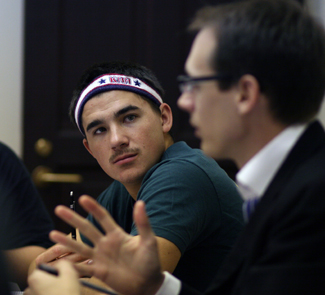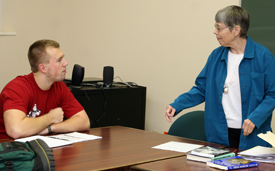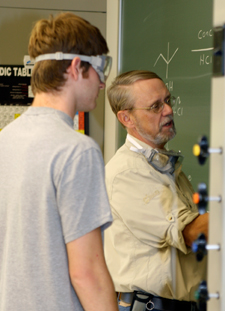Wabash freshmen and seniors scored their level of engagement higher than the national average and higher than similar Midwest institutions on 28 of 30 measurements in the 2009 National Survey of Student Engagement (NSSE).
 Students’ level of engagement remains near the top in the country and near the top of peer institutions in the Great Lakes region. More than 360,000 students attending 627 U.S. colleges and university completed the survey.
Students’ level of engagement remains near the top in the country and near the top of peer institutions in the Great Lakes region. More than 360,000 students attending 627 U.S. colleges and university completed the survey.“It’s my fourth year at Wabash, and it’s the fourth year I have had the opportunity to connect concepts I learn in class to the world outside it,” said Gary James ’10. “As a Rhetoric major, I work with professors to analyze human interactions through speeches, new media, and even public protests. As a political science minor, I also work with professors on the ins and out of policy making.”
It is that type of collaborative learning that defines the Wabash experience. Professor of Modern Languages Dan Rogers has seen the collaborative process grow through the years.
“Some of the most powerful Wabash student-faculty collaboration I’ve seen happens when we travel abroad with our students,” Rogers said. “It’s part of the culture of our institution. The biology Department has been taking students to do fieldwork in the Everglades since before some of our current students were born.
 “Professor Leslie Day started taking students to do archeology in Crete before most of the current faculty were hired. Our institutional culture of taking students out of the classroom and learning alongside them proved fertile ground as we’ve seen an explosion in travel seminars related to courses. It crosses disciplinary boundaries. You are likely to see Teacher Education students working with English students in the Ecuadorian Amazon as you are to have Biology students on the Galapagos Islands.”
“Professor Leslie Day started taking students to do archeology in Crete before most of the current faculty were hired. Our institutional culture of taking students out of the classroom and learning alongside them proved fertile ground as we’ve seen an explosion in travel seminars related to courses. It crosses disciplinary boundaries. You are likely to see Teacher Education students working with English students in the Ecuadorian Amazon as you are to have Biology students on the Galapagos Islands.”James picked up on the intensive collaboration that takes place during immersion learning. “Reading about government or social movements is interesting, but working with professors on the ground adds an entirely new, dynamic layer,” the Alabama native said. “It’s a testament to the liberal arts tradition and a hallmark of Wabash College.”
Professor of Economics Kay Widdows notes the size of the College encourages a high level of interaction and engagement.
"I think we have a couple of unique strengths that help to explain the results," she said. "One is our small size and our correspondingly small average class size, which means that we get to know the students as individuals in the classroom settings and allow us to challenge the students as individuals rather than simply teaching to the mean. When you combine that with our small footprint and the fact that most students are in residence, you have a situation where students and
faculty run into each other on campus frequently, leading to a more three-dimensional relationship than the simple the teacher-student nexus.
"Third is the fact that the professors who come here self-select into an environment where teaching and mentoring is absolutely paramount. New PhD's who want to do only their own research and hide behind closed office doors don't apply for jobs here, or if they do, certainly don't stay."
The survey questions students in five distinct categories: level of academic challenge, active and collaborative learning, student-faculty interaction, enriching education experience, and supportive campus environment. Each category is explained below along with the Wabash scores as they compare to peer colleges and the national averages.
NSSE provided a breakout of some of the individual questions to show areas of strengths and weaknesses. The Great Lakes schools are similar Midwest private colleges. The NSSE column is the national averages. The strength of the Wabash experience plays out in the survey results.
Freshmen Questions: Wabash G. Lakes NSSE
|
Had serious conversation with students of other values
|
82%
|
57%
|
56%
|
|
Wrote more than 4 papers, between 5-19 pages
|
67%
|
42%
|
33%
|
|
Participated in Community Service or Volunteered
|
78%
|
45%
|
39%
|
|
Completed foreign language coursework
|
50%
|
26%
|
21%
|
Senior Questions: Wabash G. Lakes NSSE
|
Talked about career plans w/faculty member/advisor
|
79%
|
46%
|
42%
|
|
Discussed ideas from class with faculty outside of class
|
68%
|
30%
|
28%
|
|
Completed a culminating senior experience
|
91%
|
47%
|
33%
|
|
Spent more than 5 hours/week in co-curricular activities
|
73%
|
31%
|
26%
|
The survey touches on many areas of a student’s education. Wabash men ranked the following areas very high:
For example:
- 97% of freshmen feel the institution places substantial emphasis on academics.
- 63% of freshmen frequently work harder than they though they could to meet faculty expectations.
- 26% of freshmen write more than 10papers between 5 and 19 pages and 27% have written a paper more than 20 pages in length.
- 78% of freshmen report their exams strong challenge them to do their best work.
- 71% of freshmen frequently discuss readings or ideas outside the classroom.
- By their senior year, 68% of students have participated in some form of practicum, internship, field experience, co-op or clinical assignment.
- 42% of seniors frequently assist their fellow students by tutoring or teaching them.
- By their senior year, 45% of students have done research with a faculty member.
- 98% of seniors at least occasionally discuss career plans with faculty.
- 82% of freshmen say they frequently have serious conversations with students who are different from themselves in terms of religious, political, or personal beliefs.
- 42% of freshmen frequently engage in spiritually enhancing activities such as worship, meditation, or prayer.
- By their senior year, 92% of students have participated in community service or volunteer work.
- 71% of freshmen report their peers are friendly, supportive, and help them feel as if they belong.
- 92% of freshmen report a favorable image of Wabash College; 86% of seniors would choose Wabash again if they could start their College career over.
- 94% of freshmen feel Wabash has a substantial commitment to their academic success. 51% feel well-supported by the institution regarding their social needs.
 In the five areas of effective educational practices, Wabash freshmen and seniors scored consistently above the 90th percentile and among the highest ranking institutions in the Great Lakes Region.
In the five areas of effective educational practices, Wabash freshmen and seniors scored consistently above the 90th percentile and among the highest ranking institutions in the Great Lakes Region.Level of Academic Challenge: Preparing for class (studying, reading, writing, rehearsing, etc., related to an academic program.)
Active and Collaborative Learning: Asked questions in class, made class presentations, worked with other students, tutored, participated in a community-based project.
Student-Faculty Interaction: Discussed grade or assignments with instructor, discussed career plans with faculty or advisor, discussed ideas from readings or classes with faculty outside of class, received prompt feedback from faculty on academic performance, worked with faculty on a research project outside of course or program requirements.
Enriching Educational Experience: Co-curricular activities, internship or field experience, community service or volunteer work, foreign language or study abroad, independent study, serious conversations with students of different religious beliefs, political opinions or personal values, use technology to discuss or complete an assignment.
Supportive Campus Environment: Environment provides support student needs to succeed, environment provides support to thrive socially, cope with non-academic responsibilities, quality of relationship with students, faculty and administrative personnel and offices.
 Students’ level of engagement remains near the top in the country and near the top of peer institutions in the Great Lakes region. More than 360,000 students attending 627 U.S. colleges and university completed the survey.
Students’ level of engagement remains near the top in the country and near the top of peer institutions in the Great Lakes region. More than 360,000 students attending 627 U.S. colleges and university completed the survey. “Professor Leslie Day started taking students to do archeology in Crete before most of the current faculty were hired. Our institutional culture of taking students out of the classroom and learning alongside them proved fertile ground as we’ve seen an explosion in travel seminars related to courses. It crosses disciplinary boundaries. You are likely to see Teacher Education students working with English students in the Ecuadorian Amazon as you are to have Biology students on the Galapagos Islands.”
“Professor Leslie Day started taking students to do archeology in Crete before most of the current faculty were hired. Our institutional culture of taking students out of the classroom and learning alongside them proved fertile ground as we’ve seen an explosion in travel seminars related to courses. It crosses disciplinary boundaries. You are likely to see Teacher Education students working with English students in the Ecuadorian Amazon as you are to have Biology students on the Galapagos Islands.” In the five areas of effective educational practices, Wabash freshmen and seniors scored consistently above the 90th percentile and among the highest ranking institutions in the Great Lakes Region.
In the five areas of effective educational practices, Wabash freshmen and seniors scored consistently above the 90th percentile and among the highest ranking institutions in the Great Lakes Region.